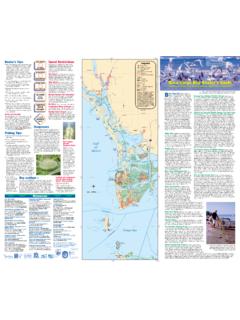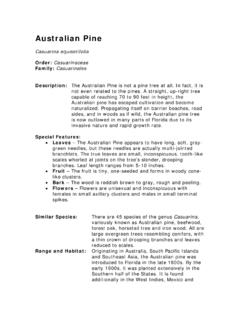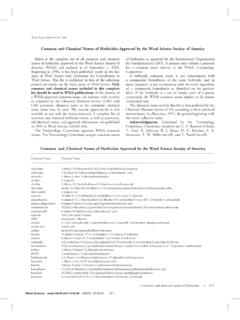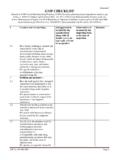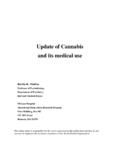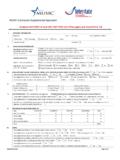Transcription of Invasive Plant Field Guide - Tampa Bay Estuary Program
1 This Guide is intended and designed to be used by bothhomeowners and professional pesticide and private land managers and other professionalsworking in utilities, parks and conservation programs willalso find useful and educational information to aid inidentifying and controlling non-native Invasive plants inthe Tampa Bay area. While there are more than 125 exoticspecies identified by the Florida Exotic Pest Plant Council(EPPC) as Category I or II pest plants , the InvasiveSpecies Task Force of Hillsborough County, Florida, hasselected 20 especially troublesome Plant species found inthe Tampa Bay region. This Field Guide provides theinformation necessary to identify and chemically treatpest plants and includes replacement suggestions forreplanting once the targeted plants are Florida EPPC regards Category I plants as: Invasiveexotics that are altering native Plant communities bydisplacing native species, changing community structuresor ecological functions, or hybridizing with natives.
2 Sixteen of the 20 species in this booklet are Category Ipest plants . The remaining four are Category II species plants on their way to becoming Category I because of increased abundance or frequency in Florida non-native Invasive is a Plant from somewhere otherthan Florida that spreads aggressively into natural non-native plants are not Invasive . They becomeinvasive when they outgrow and replace native plants innatural Plant Invasive plants threaten our natural plantcommunities and pose ecological and financial of dollars are spent each year to fight these pestplants. Local, state and federal governments, farmers andranchers, and other organizations play a role in thecontrol of non-native Invasive plants .
3 Ecologically, theseplants change the composition of natural Plant andanimal communities. Many animal species that co-existand evolve with native Plant communities cannot readilyadapt to rapid changes made to their habitats by non-native Invasive species. Invasive plants deplete the soil ofnutrients and moisture, block sunlight to native plants ,prevent access to water (for animal species), depriveanimals of nesting areas and food sources, and provideideal conditions for yet other non-native species to with non-native Invasive species tend to becomemonocultures (areas where one Plant species dominates)and greatly reduce habitat of the Field Guide4 ResourcesContact information of agencies and groupssupporting the control of non-native Invasive pestplants and encouraging native Plant Herbicide Application TechniquesThis Guide promotes three different treatmenttechniques especially suited for homeowners List of HerbicidesFor the homeowner and the Plant DescriptionsEach of the 20 plants has:Identifying characteristicsA brief botanical description; for example, leaf shapeand color, flower color, and photographsAll the photographs in this Guide were taken in theTampa Bay area!
4 Scientific and common nameThe scientific name is in brief description of where the Plant is found andmost likely to habitsHow the Plant spreads; for example, are the seedsdispersed by birds or do the plants spread by roots?Control methodsTips on controlling and eradicating the native Plant species are The Invasive Species Task ForceWhat it is and how you can get SourcesCover photo: Air potato in Hillsborough County2 Plant List10 Air potato and Air yam ..Dioscorea SuckeringAustralian-pine ..Casuarina pepper ..Schinus terebinthifolius16 Carrotwood tree ..Cupaniopsisanacardioides18 Chinaberry tree ..Melia azedarach20 Chinese tallow tree,Popcorn tree ..Sapium sebiferum22 Cogon grass.
5 Imperata cylindrica24 Guinea grass ..Panicum maximum26 Japanese climbing fern andOld World climbing fern ..Lygodium vine ..Pueraria montana30 Lead tree, Jumbie bean ..Leucaena leucocephala32 Melaleuca, Punk tree ..Melaleuca quinquenervia34 Mexican petunia ..Ruellia tweedianaMexican bluebell ..R. brittonianaBritton s wild petunia36 Rosary Pea, Crab s eyes ..Abrus precatorius38 Skunk vine ..Paederia foetida40 Torpedo grass,Bullet grass ..Panicum repens42 Tropical soda apple ..Solanum viarumPlants of Growing Concern:44 Castor bean ..Ricinus communis45 Camphor tree ..Cinnamomum camphora46 Paper mulberry ..Broussonetiapapyrifera3 Invasive Species Task ForceHillsborough County Parks,Recreation and ConservationCockroach Bay AquaticPreserve, 3709 Gulf City Road,Ruskin, Florida 33570813-671-7754 or 813-672-7876 Tampa Bay Estuary Florida WaterManagement , ext.
6 4537 Hillsborough CountyExtension to Florida s CountyExtension Service Department ofEnvironmental Protection,Bureau of Invasive lands/invaspec850-245-2809 Florida Exotic Pest Fish and Wildlife Fun_ of FloridaInstitute of Food andAgricultural Sciences,Center for Aquatic andInvasive Department ofAgriculture, NaturalResources and Exotic Speciesof North invasive_species/Florida Native Plant plants Tampa Bay area has many resources available to assistwith controlling non-native Plant species and replantingnative plants . Listed below are helpful names, numbersand/or Web sites of agencies and Plant and Non-native Invasive Plant InformationHerbicide and Chemical InformationBASF Vegetation Application TechniquesHerbicide application is a control method in which aherbicide is applied directly to the targeted nuisancevegetation via one of several application there are many effective treatment methods,this Field Guide will describe three different applicationtechniques suitable for homeowners and three techniques are foliar, basal bark and foliar method involves the application of the herbi-cide directly to the leaves of the Plant .
7 While the basalbark technique treats the bark of the Plant at or nearground level. The cut-stump method requires the Plant tobe cut down and the herbicide applied immediatelyfollowing and directly to the cut surface of the Guide indicates the most effective applicationtechnique(s) for each Invasive Plant species. Utilizing theappropriate method greatly increases the effectiveness oftreatment and reduces the need for retreatment. However,it is important to note that with the aggressive nature ofinvasive Plant species, repeated treatments are oftennecessary depending on the type and extent of aninfestation, effectiveness of the herbicide, and propertechnique selection and application.
8 (Treatmentspresented in this Guide indicate control techniques usedby Invasive Species Task Force participants.)The most effective time to apply herbicides is during thespecific growing season of the Plant being treated,particularly before seeds are fully developed and dispersedby wildlife. Generally, new vegetation is most vulnerableto herbicides and most readily absorbs the refer to the Control section of each species forspecific eradication ApplicationsThis technique involves applying water-based herbicidedirectly to the leaves and stems of a Plant . Herbicides maybe applied to the foliage of the Plant using handheld spraybottles, pump sprayers and backpack sprayers. Wettingagents (surfactants) may be added to the mix to furtherenhance leaf coverage.
9 This equipment is available athome improvement stores, garden centers or by mailorder from companies specializing in gardening small areas, products with wick or wipe-on applica-tors work well. Foliar treatment of large infestationsutilizes power-driven ground sprayers with boom5attachments to ensure adequate coverage. It is importantto remember that when using the foliar method, theherbicide may aerially drift and harm or kill non-targetplants. Be sure to follow instructions on the Bark ApplicationsThis technique consists of applying oil-based herbicidesdirectly onto the bark. Herbicides used in this method areformulated to be absorbed through the bark of the herbicide around circumference of the stem/trunkup to 12 to 20 inches above the ground using a handheldspray bottle or pump sprayer.
10 Old or rough bark mayrequire more herbicide than smooth young wood. Spray towet, but not to the point of run-off. Wind drift is less of afactor when basal bark spraying, but still should be ApplicationsThe cut-stump method is most effective for plants prone toresprouting. After mechanically cutting down the invasiveplant, the herbicide is painted, sprayed or squirted directlyonto the cut surface of the stump or stem on the circum-ference of the exposed cambium. The cambium is the layerjust inside the bark that provides the tree/ Plant with newcells for growth. For smaller stems, simply coat the cutstem(s). The stump should be cut as level as possible toprevent herbicide run-off, and herbicide should be appliedimmediately following the cut to increase herbicideeffectiveness prevent resprouting.
